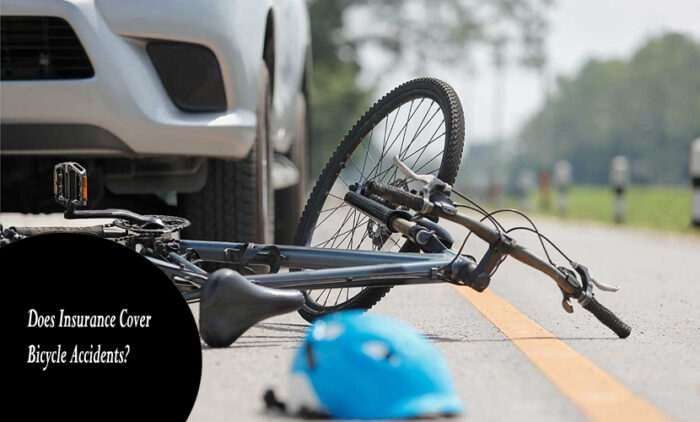Does insurance cover bicycle accidents? As cycling becomes increasingly popular for transportation, exercise, and recreation, bicycle-related accidents are on the rise, with some resulting in severe consequences.

California, in particular, sees the highest number of bicycle accident fatalities in the country. In certain circumstances, car insurance may cover injuries and damages resulting from these accidents.
In the United States, injured cyclists may be covered by car insurance through uninsured motorist coverage or personal injury protection, especially in states with no-fault insurance systems.
Additionally, cyclists might have coverage through their health insurance or homeowners/renters insurance policies, which may include bicycle and liability coverage.
In case of a bicycle collision, it’s crucial to report the incident to the police and seek immediate medical attention. In Florida, laws like the Aaron Cohen Life Protection Act require drivers involved in a collision with a cyclist to stop immediately; leaving the scene is illegal if injuries have occurred.
Does Insurance Cover Bicycle Accidents?
Indeed, insurance can provide coverage for bicycle accidents, but several factors determine the extent and nature of this coverage. For example, it depends on the specific circumstances of the accident and the types of insurance policies held by the parties involved.
If a cyclist is struck by a car, the driver’s car insurance may cover the cyclist’s property damage and injuries through uninsured motorist coverage or personal injury protection, especially if no one is at fault.
Furthermore, cyclists may have health insurance that covers medical expenses resulting from accidents, regardless of fault. Additionally, homeowners or renters insurance policies can offer protection for personal liability and property damage, which may extend to incidents involving bicycles.
Insurance Policies That Can Cover Bicycle Accidents
After a bicycle accident, victims may find assistance through various insurance policies, each tailored to address different aspects of the incident. Here’s an overview of key insurance types that could provide support:
- Car Insurance/ Auto Insurance.
- Uninsured Motorist Coverage.
- Homeowners/Renters Insurance.
- Health Insurance.
Car Insurance
In no-fault states like Florida, drivers are mandated by law to have personal injury protection (PIP) with their auto insurance, usually with a minimum coverage of $10,000.
This system aims to expedite the resolution of minor claims by settling them through the injured party’s insurance, thus avoiding court proceedings.
However, individuals retain the right to seek additional financial compensation from the at-fault party to cover any additional expenses accrued.
Uninsured Motorist Coverage
Considering Florida’s notably high rate of uninsured drivers, including uninsured motorist coverage in one’s car insurance policy is a wise choice.
This coverage becomes crucial in accidents involving bicyclists, enabling them to access the PIP minimum and potentially additional medical expenses.
To initiate a claim, physical contact with the at-fault vehicle is necessary, along with a police report, making this coverage especially valuable in hit-and-run incidents, as leaving the scene of an accident is illegal under Florida law.
Homeowners Or Renters Insurance
Cyclists can take proactive steps to secure financial protection against causing damage in an accident by obtaining homeowner’s or renter’s insurance. This type of insurance may cover the cost of a damaged bicycle or compensate for damages caused by the cyclist.
Health Insurance
For injury treatment after an accident, the victim’s health insurance typically covers initial medical expenses. However, those without insurance or facing significant out-of-pocket costs may pursue further compensation from the at-fault party.
Understanding these insurance options and potentially seeking advice from a legal expert can greatly assist in navigating the recovery process, safeguarding one’s rights and interests.
All Costs To Consider After A Bicycle Accident
In the event of a bicycle accident involving a motor vehicle, it’s crucial to report the incident to the police.
Filing a report ensures that the event is documented accurately and impartially, serving as valuable evidence for potential insurance claims or legal proceedings.
If the cyclist sustains injuries, they may file claims to cover both initial and subsequent treatments. Injuries can range from minor traumas causing minimal harm to severe injuries requiring extensive care.
Common injuries from such accidents include damage to the head, face, bones, chest, abdomen, and skin. Medical claims may potentially cover:
- Immediate medical attention.
- Subsequent medical consultations.
- Urgent care services.
- Medications prescribed.
- Medical devices.
- Earnings lost due to temporary disability.
- Diminished future earning ability.
- Doctor’s visits.
This list serves as an indication and is not exhaustive, as each accident and its resulting claims will vary depending on the specific circumstances.
Additionally, claims for property damage, particularly concerning the bicycle, may also be submitted.
Cyclists, especially those who regularly ride in traffic, may own high-end bicycles that represent significant financial investments, thus incurring substantial costs in damages.
Final Thoughts
Insurance coverage for bicycle accidents can be intricate, but there are various avenues through which cyclists and other involved parties can seek compensation for damages, injuries, and other losses.
Car insurance, such as personal injury protection and uninsured motorist coverage, along with homeowner’s or renter’s insurance, and personal health insurance, all have the potential to contribute to covering the aftermath of a bicycle accident.


